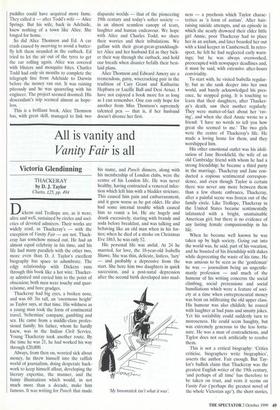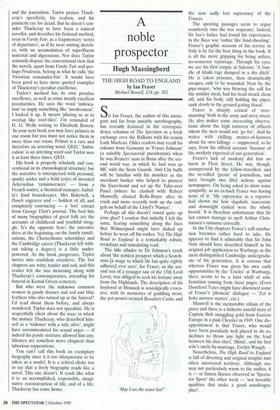All is vanity and Vanity Fair is all
Victoria Glendinning
THACKERAY by D. J. Taylor Chatto, £25, pp. 494
Dickens and Trotlope are, as it were, alive and well, sustained by circles and soci- eties of devoted admirers. Their works are widely read, as Thackeray's — with the exception of Vanity Fair — are not. Thack- eray has somehow missed out. He had an almost equal celebrity in his time, and his life had many parallels with the other two, more even than D. J. Taylor's excellent biography has space to adumbrate. The edgy relationship with Dickens runs through this book like a hot wire. Thacker- ay admired and envied him to the point of obsession; both men were touchy and quar- relsome, and bore grudges.
Thackeray had big eyes, a broken nose, and was 6ft 3M tall, an 'enormous height' as Taylor says, at that time. His wildness as a young man took the form of continental travel, 'bohemian' company, gambling and sex. He came from a middle-class profes- sional family; his father, whom he hardly knew, was in the Indian Civil Service. Young Thackeray took another route. By the time he was 21, he had worked his way through £20,000.
Always, from then on, worried sick about money, he threw himself into the raffish world of journalism, doing desperate hack- work to keep himself afloat, developing the literary expertise, the manner, and the funny illustrations which would, in not much more than a decade, make him famous. It was writing for Punch that made his name, and Punch dinners, along with his membership of London clubs, were the centre of his London life. He was never healthy, having contracted a venereal infec- tion which left him with a bladder stricture. This caused him pain and embarrassment, and it grew worse as he got older. He also had some internal trouble which caused him to vomit a lot. He ate hugely and drank excessively, starting with brandy and soda before breakfast, and was talking and behaving like an old man when in his for- ties; when he died of a stroke on Christmas Eve 1863, he was only 52.
His personal life was awful. At 24 he married, for love, the 18-year-old Isabella Shawe. She was thin, delicate, listless, 'lazy' — and probably a depressive from the start. She bore him two daughters in quick succession, and a post-natal depression after the second birth developed into mad- 'My broomstick isn't what it was
ness — a psychosis which Taylor charac- terises as 'a form of autism'. After hair- raising suicide attempts, and an episode in which she nearly drowned their elder little girl Annie, poor Thackeray had to place her in an asylum, and later boarded her out with a kind keeper in Camberwell. In retro- spect, he felt he had neglected early warn- ings; but he was always overworked, preoccupied with newspaper deadlines and, it must be said, with extensive after-hours conviviality.
To start with, he visited Isabella regular- ly; but as she sank deeper into her own world, and barely acknowledged his pres- ence, he stopped going. It is touching to learn that their daughters, after Thacker- ay's death, saw their mother regularly. They were matter-of-fact about her 'rav- ing', and when she died Annie wrote to a friend: 'I have no words to tell you how great she seemed to me.' The two girls were the centre of Thackeray's life. He made a loving home for them, and they worshipped him.
His other emotional outlet was his idoli- sation of Jane Brookfield, the wife of an old Cambridge friend with whom he had a strong friendship; he became a third party in the marriage. Thackeray and Jane con- ducted a copious sentimental correspon- dence, and even though Taylor is certain there was never any more between them than a few chaste embraces, Thackeray, after a painful scene was frozen out of the family circle. Like Trollope, Thackeray in the United States became sentimentally infatuated with a bright, unattainable American girl; but there is no evidence of any lasting female companionship in his life.
When he became well known he was taken up by high society. Going out into the world was, he said, part of his vocation, and he boasted of his friendship with dukes while deprecating the waste of his time. He was anxious to be seen as the 'gentleman' he was — journalism being an ungentle- manly profession — and much of the humour of his writing concerns the social climbing, social pretensions and social humiliations which were a feature of soci- ety at a time when entrepreneurial money was bent on infiltrating the old upper class. His humour was also childish; he roared with laughter at bad puns and smutty jokes. Yet his sociability could suddenly turn to moroseness. He could seem haughty, but was extremely generous to the less fortu- nate. He was a man of contradictions, and Taylor does not seek artificially to resolve them.
This is not a critical biography: 'Critics criticise, biographers write biographies', asserts the author. Fair enough. But Tay- lor's bullish claim that Thackeray was the greatest English writer of the 19th century,
'and perhaps of all time' has therefore to be taken on trust, and rests it seems on Vanity Fair ('perhaps the greatest novel of the whole Victorian age'), the short stories,
and the journalism. Taylor praises Thack- eray's specificity, his realism, and his painterly eye for detail. But he doesn't con- sider Thackeray to have been a natural novelist, and describes his fictional method,
even in Vanity Fair, as a fragmentary 'series of departures', as if he were writing sketch-
es, with an accumulation of superfluous material and digressions. Nor does Taylor seriously dispute the conventional view that
the novels, apart from Vanity Fair and per- haps Pendennis, belong in what he calls 'the Victorian remainder-bin'. It would have been good to have more quoted examples of Thackeray's peculiar excellence.
Taylor's method has its own peculiar excellence, as well as some mostly excellent peculiarities. He uses the word 'imbrica- tion' to imply something like 'involvement'. I looked it up. It means 'placing so as to overlap like roof-tiles'. I'm reminded of H. G. Wells writing to Elizabeth Bowen: 'In your next book you may have pelmets in one room but you must not notice them in more than one room. Pelmet is a rare and therefore an arresting word. QED.' Imbri- cation' is an arresting word and Taylor uses it at least three times. QED.
His book is properly scholarly and con- ventional in its chronological structure; but the narrative is interspersed with personal, sparky asides and a bold series of invented Ackroydian 'reminiscences' — from a French waiter, a theatrical manager, Isabel-
la's kind housekeeper, Mrs Bakewell, a Punch engraver and — boldest of all, and
completely convincing — a 'lost' extract from George Eliot's journal. The best bits of many biographies of great folk are the accounts of childhood and youthful strug- gle. It's the opposite here; the narrative drive at the beginning, on the family ramifi- cations, the Charterhouse schooldays and the Cambridge career (Thackeray left with- out taking a degree) is a little under- powered.. As the book progresses, Taylor moves into confident overdrive. The last chapters are witty, tender and sad, and this reader felt she was mourning along with Thackeray's contemporaries, attending his funeral in Kensal Green cemetery.
But who were the unknown common women in gaudy dresses and red and blue feathers who also turned up at the funeral?
I'd read about them before, and always wondered. Taylor does not speculate. He is respectfully silent about the ways in which the mature Thackeray, who described him- self as a 'widower with a wife alive', might have accommodated his sexual urges — if indeed his penile stricture allowed him any. Silences are somehow more eloquent than laborious suppositions.
You can't call this book an exemplary biography since it is too idiosyncratic to be taken as a model. It is a critical cliché too to say that a lively biography reads like a novel. This one doesn't. It reads like what it is: an accomplished, responsible, imagi- native reconstruction of life, and of a life. Thackeray has come home.











































































 Previous page
Previous page